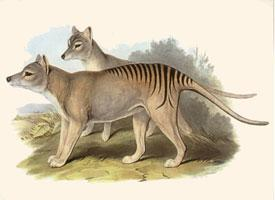
Weights and measures
| Height at the shoulder | 90 cm |
|---|
State of endangerment
| Extinct |
Animal description
The Thylacine, scientifically known as Thylacinus cynocephalus, and commonly referred to as the Tasmanian Tiger or Tasmanian Wolf, is an extinct marsupial that was native to Australia, Tasmania, and New Guinea. This fascinating creature has captured the imagination of scientists, historians, and the general public alike, due to its unique appearance and the mystery surrounding its extinction.Physically, the Thylacine was a striking animal. It had a lean, dog-like body, but with some distinctly marsupial features, such as a pouch in both females and males (the latter used for protecting the genitalia). The most distinctive feature of the Thylacine was its coat, which was sandy or yellowish-brown with a series of dark stripes across its back, reminiscent of a tiger's stripes, hence the name "Tasmanian Tiger." Adult Thylacines could reach lengths of about 180 to 190 centimeters (approximately 5.9 to 6.2 feet) from the tip of the nose to the tail, standing about 60 centimeters (about 2 feet) tall at the shoulder and weighing up to 30 kilograms (around 66 pounds).
The Thylacine was a nocturnal and crepuscular hunter, primarily preying on small animals such as birds, kangaroos, and wallabies. Its jaw was remarkably flexible; fossil evidence and recorded observations suggest that it could open its mouth to an almost 180-degree angle, which is much wider than any of the modern-day carnivores. This characteristic might have been an adaptation to capture larger prey, but it also contributed to the Thylacine's eerie and formidable reputation.
Despite its fearsome appearance, the Thylacine's diet and behavior suggest it was a shy and elusive creature, preferring to avoid human contact. Its lifestyle was likely solitary or involving small family groups, with territories marked and defended against others.
The reasons behind the Thylacine's extinction are complex and multifaceted, involving a combination of human impact and ecological changes. European settlers hunted the Thylacine extensively, blaming it for the deaths of sheep and other livestock, often without evidence. Furthermore, the introduction of dogs, habitat destruction, and competition for food with other introduced species like the European fox contributed to its decline. The last known Thylacine died in captivity in the Hobart Zoo, Tasmania, on September 7, 1936.
Despite its extinction, the Thylacine remains an icon of conservation and a reminder of the impact humans can have on the natural world. Its image provokes both fascination and regret, serving as a poignant symbol of lost natural heritage. Periodically, unconfirmed sightings and speculation about the Thylacine's survival in remote parts of Tasmania spark hope and interest, though no concrete evidence has emerged to suggest that this remarkable creature still roams the wilderness. The Thylacine's legacy endures, inspiring efforts to protect and preserve the world's remaining species from a similar fate.
New photos of animals
Top 10 animals
- Dolphin gull (Leucophaeus scoresbii)
- Diana monkey (Cercopithecus diana)
- Moustached guenon (Cercopithecus cephus)
- Greek tortoise (Testudo graeca)
- Stone loach (Barbatula barbatula)
- Galápagos tortoise (Geochelone nigra complex)
- Japanese macaque (Macaca fuscata)
- Russian tortoise (Testudo horsfieldii)
- Common flying dragon (Draco volans)
- Galápagos penguin (Spheniscus mendiculus)